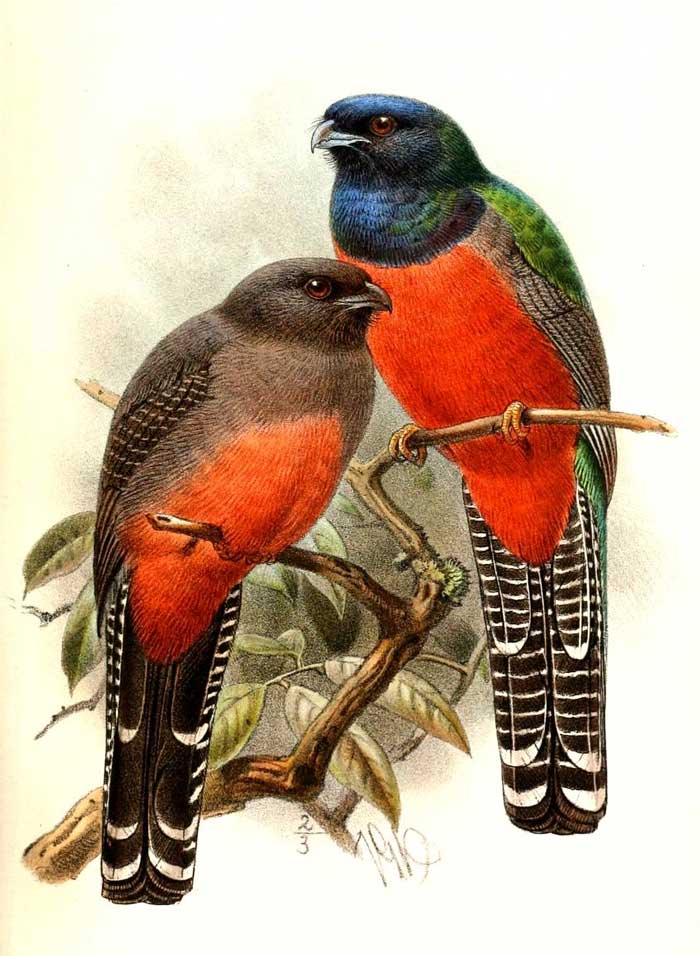
Trogon curucui
Superregnum: Eukaryota
Regnum: Animalia
Subregnum: Eumetazoa
Cladus: Bilateria
Cladus: Nephrozoa
Superphylum: Deuterostomia
Phylum: Chordata
Subphylum: Vertebrata
Infraphylum: Gnathostomata
Superclassis: Tetrapoda
Cladus: Reptiliomorpha
Cladus: Amniota
Classis: Reptilia
Cladus: Eureptilia
Cladus: Romeriida
Subclassis: Diapsida
Cladus: Sauria
Infraclassis: Archosauromorpha
Cladus: Crurotarsi
Divisio: Archosauria
Subsectio: Ornithodira
Subtaxon: Dinosauromorpha
Cladus: Dinosauria
Ordo: Saurischia
Cladus: Eusaurischia
Cladus: Theropoda
Cladus: Neotheropoda
Cladus: Averostra
Cladus: Tetanurae
Cladus: Avetheropoda
Cladus: Coelurosauria
Cladus: Maniraptoromorpha
Cladus: Maniraptoriformes
Cladus: Maniraptora
Cladus: Pennaraptora
Cladus: Eumaniraptora
Cladus: Avialae
Infraclassis: Aves
Cladus: Euavialae
Cladus: Avebrevicauda
Cladus: Pygostylia
Cladus: Ornithothoraces
Cladus: Euornithes
Cladus: Ornithuromorpha
Cladus: Ornithurae
Cladus: Carinatae
Parvclassis: Neornithes
Cohors: Neognathae
Ordo: Trogoniformes
Familia: Trogonidae
Genus: Trogon
Species: Trogon curucui
Subspecies: T. c. behni - T. c. bolivianus - T. c. curucui - T. c. peruvianus
Name
Trogon curucui Linnaeus, 1766
References
Systema Naturae ed.12 p. 167
Vernacular names
Deutsch: Blauscheiteltrogon
English: Blue-crowned Trogon
The blue-crowned trogon (Trogon curucui) is a species of bird in the family Trogonidae, the quetzals and trogons. It is found in Argentina, Bolivia, Brazil, Colombia, Ecuador, Paraguay, and Peru.[2][3]
Taxonomy and systematics
The blue-crowned trogon's early taxonomic history is contorted, but since the mid 1900s it has settled on its current state. Three subspecies are recognized, the nominate T. c. curucui, T. c. peruvianus, and T. c. behni.[4][2]
Illustration by Keulemans, 1892
Description
The blue-crowned trogon is about 24 cm (9.4 in) long and weighs 39 to 63 g (1.4 to 2.2 oz). The male of the nominate subspecies has a blackish face and throat with an orange ring around the eye. The crown, sides of the neck, and breast are glossy greenish blue, the nape turquoise-green, and the back metallic bronzy green. The upperside of the tail is greenish blue and the underside has black and white bars. The folded wing has fine vermiculation that looks gray at a distance. The breast is separated from the rosy red belly and vent by a white band. The female is gray where the male is green and the belly is pinkish red. Instead of the orange ring around the eye there are white arcs before and after it. The underside of the tail has a different black and white pattern. The male of T. c. peruvianus has a bluish gloss to the bronzy green back, a much reduced white breast band, and narrower white bars on the undertail. The male T. c. behni's back is more intensely bronze than the nominate's, and the breast is greener.[5]
Distribution and habitat
The blue-crowned trogon is found throughout the Amazon Basin south of the Amazon River and south and east from there as well. The nominate subspecies is found from Amazonian central Brazil east to the Atlantic Ocean. T. c. peruvianus is found in the Andean foothills of southern Colombia, eastern Ecuador and Peru, and northwestern Bolivia and from there east into Amazonian Brazil as far as the Tapajós River. T. c. behni is found in eastern and southern Bolivia, southwestern Brazil, much of Paraguay, and northern Argentina.[2][5]
The blue-crowned trogon inhabits a variety of landscapes across its large range. Forest types include várzea, gallery, tall secondary, and dry semi-deciduous. It occupies all levels from the understory to the canopy. It is also found in savanna woodland, dry palm forest, caatinga, and scrublands. In the northen part of its range it seldom occurs above 500 m (1,600 ft) of elevation but reaches as high as 1,500 m (4,900 ft) in Argentina and 1,750 m (5,700 ft) in Bolivia.[5]
Behavior
Feeding
The blue-crowned trogon's diet includes a wide variety of insects and spiders, and also fruits. It sometimes joins mixed-species foraging flocks.[5]
Breeding
The blue-crowned trogon's breeding season varies across its range. It starts as early as May in Colombia and spans from October to December in Argentina. It nests in cavities in arboreal termitaria. The clutch size is two or three eggs.[5]
Dickcissel male perched on a metal pole singing, with neck stretched and beak open.
Songs and calls
Listen to blue-crowned trogon on xeno-canto
Vocalization
The male blue-crowned trogon's song is "a fast, evenly paced repetition of...'kow' [notes], lasting about 4-5 seconds and ending abruptly". Both sexes give a "churrr" call.[6]
Status
The IUCN has assessed the blue-crowned trogon as being of Least Concern, though its population is unknown and is believed to be decreasing.[1] It is rare to common in different parts of its range and occurs in several protected areas in Boliva, Brazil, and Argentina.[5]
References
BirdLife International (2018). "Blue-crowned Trogon Trogon curucui". IUCN Red List of Threatened Species. 2018. Retrieved 26 October 2021.
Gill, F.; Donsker, D.; Rasmussen, P. (July 2021). "IOC World Bird List (v 11.2)". Retrieved July 14, 2021.
Remsen, J. V., Jr., J. I. Areta, E. Bonaccorso, S. Claramunt, A. Jaramillo, D. F. Lane, J. F. Pacheco, M. B. Robbins, F. G. Stiles, and K. J. Zimmer. Version 24 August 2021. Species Lists of Birds for South American Countries and Territories. https://www.museum.lsu.edu/~Remsen/SACCCountryLists.htm retrieved August 24, 2021
Remsen, J. V., Jr., J. I. Areta, E. Bonaccorso, S. Claramunt, A. Jaramillo, D. F. Lane, J. F. Pacheco, M. B. Robbins, F. G. Stiles, and K. J. Zimmer. Version 24 August 2021. A classification of the bird species of South America. American Ornithological Society. https://www.museum.lsu.edu/~Remsen/SACCBaseline.htm retrieved August 24, 2021
Collar, N. (2020). Blue-crowned Trogon (Trogon curucui), version 1.0. In Birds of the World (J. del Hoyo, A. Elliott, J. Sargatal, D. A. Christie, and E. de Juana, Editors). Cornell Lab of Ornithology, Ithaca, NY, USA. https://doi.org/10.2173/bow.blctro1.01 retrieved October 26, 2021
Ridgely, Robert S.; Greenfield, Paul J. (2001). The Birds of Ecuador: Field Guide. Vol. II. Ithaca: Cornell University Press. p. 302. ISBN 978-0-8014-8721-7.
Retrieved from "http://en.wikipedia.org/"
All text is available under the terms of the GNU Free Documentation License

